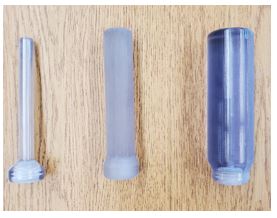Efforts Toward Informed Pipette Design
Students: Nolan Norton
Investigators: Ken Fischer, PhD; Terence McIff, PhD; E. Bruce Toby, MD
These studies focus on the basal joint of the thumb, otherwise known as the thumb carpometacarpal (CMC) joint or the trapeziometacarpal (TMC) joint. Out of all the joints in the hand and wrist, why study this joint? Because it is afflicted with osteoarthritis (OA) very frequently. How often? Thumb CMC OA affects 1 in 12 men and 1 in 4 women. Thus, women are at 3 times the risk as men, and also 1 in 2 women over 50 years of age have OA in this joint. Also, thumb function is critical to nearly every task of daily living involving the hand. Loss or impediment of thumb function greatly reduces one’s quality of life. Thus, anything we can do to understand the causes and develop interventions and treatments will have a positive impact on the lives of many aging adults.
Our past research in this area involved investigating joint contact pressure patterns to see if there was a relationship between contact pressure levels and locations and other clinical measures, such as joint instability as measured during stress X-ray, during the common loading modes of tip pinch, key pinch, and spherical grasp. The goal was to reveal reliable ways to screen people, especially women, for risk of developing OA before their joint begin to deteriorate.
Our current research efforts in this area are focused on the effects of pipette design on the CMC joint. The use of manual pipettes has been associated with a high prevalence of upper extremity and neck cumulative trauma disorders and work-related musculoskeletal disorders among laboratory workers. The primary risk factor for these disorders are poor ergonomics in three specific areas: posture, repetition and force. Injuries and/or pathologies due to repetitive stresses on the hand and wrist account for a substantial amount of pain and suffering, time lost from work, and health care costs. Thus, understanding how different design parameters affect the thumb and hand can have a positive impact on scientists and others who frequent use pipettes.
How are we doing it? With state-of-the-art imaged-based computational modeling! Each subject undergoes a high resolution MRI scan from which we build a geometric model of their thumb CMC joint. Subjects are also scanned while they perform a functional task (such as isometric tip pinch, key pinch, spherical grasp and pipetting) with visual feedback to help them maintain constant force. We use these scans during active functional loading to develop matching boundary conditions for finite element analysis of the joint contact pressure. That data is compared with the clinical measures described above and between gender and age groups.

